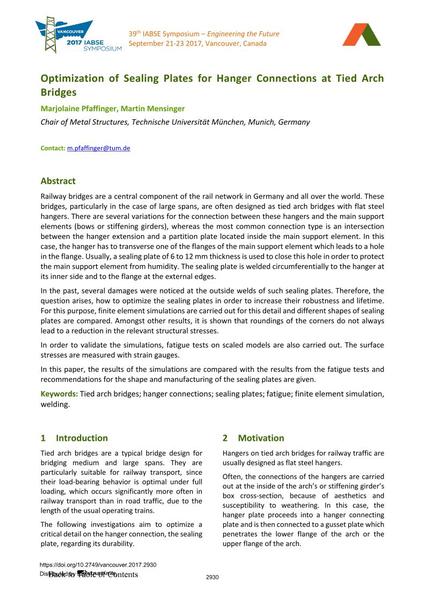Optimization of Sealing Plates for Hanger Connections at Tied Arch Bridges

|
|
|||||||||||
Bibliographic Details
| Author(s): |
Marjolaine Pfaffinger
(Chair of Metal Structures, Technische Universität München, Munich, Germany)
Martin Mensinger (Chair of Metal Structures, Technische Universität München, Munich, Germany) |
||||
|---|---|---|---|---|---|
| Medium: | conference paper | ||||
| Language(s): | English | ||||
| Conference: | IABSE Symposium: Engineering the Future, Vancouver, Canada, 21-23 September 2017 | ||||
| Published in: | IABSE Symposium Vancouver 2017 | ||||
|
|||||
| Page(s): | 2930-2936 | ||||
| Total no. of pages: | 7 | ||||
| Year: | 2017 | ||||
| DOI: | 10.2749/vancouver.2017.2930 | ||||
| Abstract: |
Railway bridges are a central component of the rail network in Germany and all over the world. These bridges, particularly in the case of large spans, are often designed as tied arch bridges with flat steel hangers. There are several variations for the connection between these hangers and the main support elements (bows or stiffening girders), whereas the most common connection type is an intersection between the hanger extension and a partition plate located inside the main support element. In this case, the hanger has to transverse one of the flanges of the main support element which leads to a hole in the flange. Usually, a sealing plate of 6 to 12 mm thickness is used to close this hole in order to protect the main support element from humidity. The sealing plate is welded circumferentially to the hanger at its inner side and to the flange at the external edges. In the past, several damages were noticed at the outside welds of such sealing plates. Therefore, the question arises, how to optimize the sealing plates in order to increase their robustness and lifetime. For this purpose, finite element simulations are carried out for this detail and different shapes of sealing plates are compared. Amongst other results, it is shown that roundings of the corners do not always lead to a reduction in the relevant structural stresses. In order to validate the simulations, fatigue tests on scaled models are also carried out. The surface stresses are measured with strain gauges. In this paper, the results of the simulations are compared with the results from the fatigue tests and recommendations for the shape and manufacturing of the sealing plates are given. |
||||
| Keywords: |
fatigue welding tied-arch bridges finite element simulation hanger connections sealing plates
|
||||
